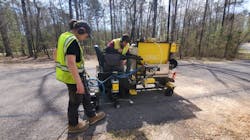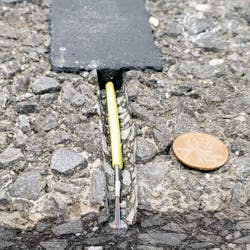Technology Allows Fiber to be ‘Painted’ Onto Pavement
Traxyl offers a last-mile fiber installation technology called FiberTRAX, which it says is an efficient and effective alternative to microtrenching. The company says the installation process amounts to painting fiber onto a paved surface.
“FiberTRAX delivers rapid, on-demand surface-level fiber that makes once-daunting installations simple and cost-effective, even in remote and hard-to-reach areas,” the company says. A significant difference between the FiberTRAX and microtrenching is depth. According to Traxyl, the typical depth of a microtrenching cut is between 8 and 27 inches (200-685 mm). By comparison, the FiberTRAX process “etches” the surface, the company says. That etch is between 0.3 and 0.6 inches in depth (8-15 mm).
In a document titled “FiberTRAX vs. Microtrenching,” Traxyl says microtrenching “requires utility identification because of the depths that cuts are made through the paved surfaces. The process uses multiple, large pieces of machinery, each with its own construction crews.” FiberTRAX is applied using a machine called a TRAXtor. Traxyl explains, “Our automated TRAX installation machines make installing infrastructure like optical fiber as easy as painting a line. They work quickly to reduce installation time from weeks and months to hours and days.” The machine, which is similar in size to a lawn tractor, can install fiber at 1,000 feet per hour, Traxyl says.
Pointing to the TRAXtor machines’ “ability to perform a minimally disruptive installation,” Traxyl says using these machines “eliminates the need for digging, trenching, or the risk of accidentally cutting other utilities. By avoiding traditional and invasive techniques, installation costs, maintenance expenses, and lead times are all significantly reduced.
“All in the same forward motion, a cable is inserted into the channel and a highly durable resin backfills the groove and cable payload to seal the cable into the pavement surface,” the company continues. “The protective coating is cured in under an hour, allowing traffic and pedestrians who resume with no impact to operations. FiberTRAX can accommodate from 2 to 96 fibers, which is perfect for last-mile and campus environments. Manual intervention may be required to accommodate more than 24 fibers.”
Thanks in part to the shallow etch needed for a FiberTRAX installation, the cleanup process is quick and efficient compared to microtrenching, Traxyl asserts. Describing the FiberTRAX cleanup process, the company explains, “The minimal debris is vacuumed by the TRAXtor and can be disposed of in bags. This is unlike microtrenching, where debris is disposed of by trucks.”

